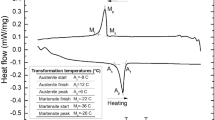Abstract
With the rapid development of microscale cellular structures, the small-diameter cold-formed welded stainless steel tubes have recently been used for creating the metallic lattice topologies with high mechanical properties. In this paper, to obtain the accurate material properties of the circular hollow section (CHS) under pure compression, a series of concentric compression tests are conducted on the millimeter-scale cold-formed 304 stainless steel circular tubular stub columns after exposure to a vacuum brazing process. The tests cover a total of 18 small-diameter stub tubes with measured thickness-to-diameter ratios (t / D) from 0.023 to 0.201. A generalized three-stage nominal stress–strain model is developed for describing the compressive behavior of the post-brazing CHSs over the full strain range. This mechanical model is especially applicable to computer code implementation. Hence, an interactive computer program is developed to simultaneously optimize three strain hardening exponents \((n_1 ,n_2 ,n_3 )\) in the expression of the model to produce the stress–strain curve capable of accurately replicating the test data. To further reduce the number of the model and material parameters on which this model depends, this paper also develops five expressions for determining the 2.5% proof stress \((\sigma _{p_2 } )\), \(n_2 \), the ultimate compressive strength \((\sigma _{p_3 } )\), \(n_3 \), and the ultimate plastic strain \((p_3 \% )\) for given experimental values of three basic material parameters \((E_0 ,\sigma _{0.01} ,\sigma _{0.2} )\). These expressions are validated to be effective for the CHSs with \(t{/}D\ge 0.027\). The analytically predicted full-range stress–strain curves have generally shown close agreement with the ones obtained experimentally.











Similar content being viewed by others
References
Harris JA, Winter RE, McShane GJ. Impact response of additively manufactured metallic hybrid lattice materials. Int J Impact Eng. 2017;104:177–91.
Dobrić J, Buđevac D, Marković Z, Gluhović N. Behaviour of stainless steel press-braked channel sections under compression. J Constr Steel Res. 2017;139:236–53.
Quach WM, Teng JG, Chung KF. Residual stresses in press-braked stainless steel sections, I: Coiling and uncoiling of sheets. J Constr Steel Res. 2009;65:1803–15.
Wardenier J, Packer JA, Zhao XL, van der Vegte GJ. Hollow sections in structural applications. 2nd ed. Geneva: CIDECT; 2010.
Zhan M, Guo K, Yang H. Advances and trends in plastic forming technologies for welded tubes. Chin J Aeronaut. 2016;29:305–15.
Gao L, Sun H, Jin F, Fan H. Load-carrying capacity of high-strength steel box-sections I: stub columns. J Constr Steel Res. 2009;65:918–24.
Zhao O, Gardner L, Young B. Structural performance of stainless steel circular hollow sections under combined axial load and bending—part 1: experiments and numerical modelling. Thin-Walled Struct. 2016;101:231–9.
Guo L, Yang S, Jiao H. Behavior of thin-walled circular hollow section tubes subjected to bending. Thin-Walled Struct. 2013;73:281–9.
Hu B, Wu L, Xiong J, Ma L, Yang W, Jin Y. Mechanical properties of a node-interlocking pyramidal welded tube lattice sandwich structure. Mech Mater. 2018 (Under review).
Felicetti R, Gambarova PG, Meda A. Residual behavior of steel rebars and R/C sections after a fire. Constr Build Mater. 2009;23:3546–55.
Rasmussen KJR. Full-range stress–strain curves for stainless steel alloys. J Constr Steel Res. 2003;59:47–61.
Gardner L, Ashraf M. Structural design for non-linear metallic materials. Eng Struct. 2006;28:926–34.
Quach WM, Teng JG, Chung KF. Three-stage full-range stress–strain model for stainless steels. J Struct Eng. 2008;134:1518–27.
Rossi B, Afshan S, Gardner L. Strength enhancements in cold-formed structural sections—part II: predictive models. J Constr Steel Res. 2013;83:189–96.
Chen J, Young B. Stress–strain curves for stainless steel at elevated temperatures. Eng Struct. 2006;28:229–39.
Tao Z, Wang X-Q, Uy B. Stress–strain curves of structural and reinforcing steels after exposure to elevated temperatures. J Mater Civ Eng. 2013;25:1306–16.
Wang X-Q, Tao Z, Song T-Y, Han L-H. Stress–strain model of austenitic stainless steel after exposure to elevated temperatures. J Constr Steel Res. 2014;99:129–39.
Rasmussen KJR, Hancock GJ. Design of cold-formed stainless steel tubular members. I: columns. J Struct Eng. 1993;119:2349–67.
SEI/ASCE 8-02. Specification for the design of cold-formed stainless steel structural members. Reston: American Society of Civil Engineers (ASCE); 2002.
Gardner L, Nethercot DA. Numerical modeling of stainless steel structural components—a consistent approach. J Struct Eng. 2004;130:1586–601.
Ziemian RD. Guide to stability design criteria for metal structures. 6th ed. Hoboken: Wiley; 2010.
Acknowledgements
The work was supported by the National Natural Science Foundation of China under Grant Nos. 11432004 and 11421091.
Author information
Authors and Affiliations
Corresponding author
Rights and permissions
About this article
Cite this article
Hu, B., Jin, Y. & Wu, LZ. Full-Range Compressive Stress–Strain Curves for Cold-Formed 304 Stainless Steel Circular Hollow Sections After Exposure to Vacuum Brazing. Acta Mech. Solida Sin. 31, 557–572 (2018). https://doi.org/10.1007/s10338-018-0055-1
Received:
Revised:
Accepted:
Published:
Issue Date:
DOI: https://doi.org/10.1007/s10338-018-0055-1




